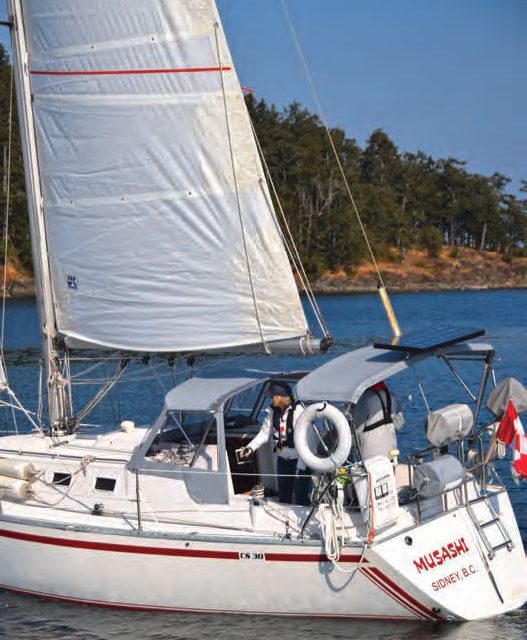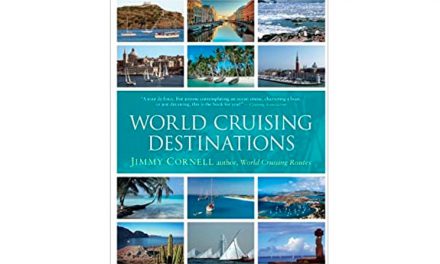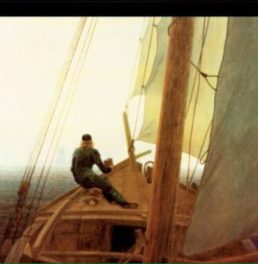A quick racer/cruiser from Canada
Issue 150: May/June 2023
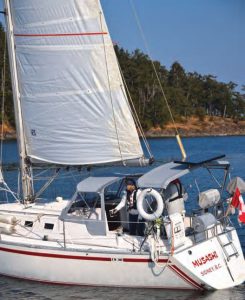
Musashi’s stern carries an abundance of safety gear, plus a barbecue, swim ladder, anchor rode reel, and bimini with solar panel.
When Jack and Marilyn Williams moved west from their home province of Ontario in 1977, settling near Victoria on Vancouver Island, one of their priorities was to get out on the surrounding ocean.
They sailed their first boat, an O’Day 27 purchased in 1978, extensively through the spectacular cruising grounds of British Columbia, including a voyage out to Barkley Sound on Vancouver Island’s wild west coast. With an appetite for more distant horizons, the couple decided they wanted a bigger boat. A friend of theirs sailed a Canadian Sailcraft 36, a significantly larger boat and a bit more than they were prepared to take on. But they were impressed by Canadian Sailcraft design and workmanship and found a 1986 CS 30 that met all their expectations.
Jack and Marilyn were soon the owners of Musashi, named for a historical Japanese folk hero of the samurai era — an author, artist, philosopher, and swordsman. An artistic rendering of the hero remains framed on the cabin bulkhead.
With Musashi their sailing life expanded, including a 1991 Vancouver Island circumnavigation, a 30-day, 800-nautical mile adventure proving the CS 30 capable of open ocean seas and winds. Winds on the west coast can easily reach 40 knots at headlands, with whitecapped following seas under blue skies — a sailor’s dream. In the following years, they cruised Washington state’s Puget Sound, the Broughton Archipelago to the north, and the Canadian Gulf Islands.
 Design
Design
Leaning toward the IOR-influenced designs of the 1980s, the CS 30 is essentially a slippery hull that also features a comfortable cruising interior. Created by transplanted British designer Tony Castro, the CS 30 complemented the Canadian Sailcraft lineup between the 27 and 33. With an extensive background in developing race boats to current rules, Castro created a go-fast cruising boat that excels on all points of sail. A slim bow, beamy midship, and tapered stern all point to a hull that will sail well on the wind. The tall rig and deep keel complement that ability, and Castro designed both wing-keel and shoal-draft keel versions.
Construction
Canadian Sailcraft had a well-earned reputation for quality construction and finish. The company built 500 CS 30s at its factory in Brampton, Ontario, between 1984 and 1990. The single-skin hull with balsa-cored deck produced a comparatively light hull strengthened by a bonded fiberglass substructure under teak-and-holly floor panels.
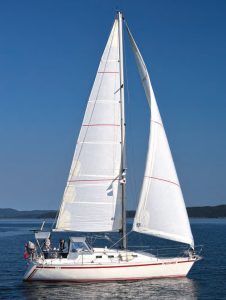
The CS 30 sports a fairly flat sheer, raked bow, reverse transom, and a
tall rig. Jack and Marilyn purchased a new full-batten mainsail and 110% genoa. These, along with an asymmetrical spinnaker in a sock and a seldom-used 150% genoa, complete the sail inventory. Lazy-jacks make easy work of lowering the mainsail.
The hull/deck joint is an inward-turned flange bolted through the anodized toerail on 4-inch centers with butyl tape used as a sealant. Interestingly, while most aluminum toerails of this era were slotted, the CS 30 has evenly spaced holes that serve as handy attachment points for turning blocks or fenders.
The 3,440-pound lead fin keel draws 5 feet 6 inches. The optional wing keel adds another 140 pounds with a 4-foot 6-inch draft, and the shoal keel is 400 pounds heavier with a 4-foot 3-inch draft. All three keel options are attached directly to the hull with a double row of stainless steel bolts. There is no keel stub as part of the hull, which results in a very shallow bilge sump under the floorboards, too shallow for the installation of a standard immersion-style bilge pump. A factory-installed manual pump is easily accessible from the helm position in the cockpit locker. Jack reports that the sump is generally dry, but with such a small capacity in the bilge before the floorboards start floating, I would install a remote bilge pump with a high-water alarm.
Deck and Rigging
The Isomat keel-stepped, double-spreader anodized aluminum mast has all shrouds terminating at single chainplates set well inboard of the toerail. This leaves a clear, unobstructed passage forward. However, without lower shrouds spaced fore and aft there is a risk of mast pumping in heavy seas. A jackstay has been provided as a preventive measure. The chainplates are bolted to the internal bulkhead, tucked behind removable fiberglass covers. On our review boat there was some evidence of water leaks in this area, so sealant around the chainplates should be checked regularly.

Halyards are led aft from the mast base through turning blocks.
The mast has an integrated spinnaker track on the forward side, with control lines for the car included. However, without bearings on the car, it would be difficult to move under load. All running rigging is internal to the mast and exits at the base, turning out to deck organizers and aft to line stoppers with Lewmar 30 self-tailing winches. This is a perfect setup for the cruising family or singlehanded sailor, but not ideal for the racer as it’s going to get crowded in the cockpit.
The stem fitting at the bow is cast aluminum, incorporating a single bow roller and fairleads for docklines. The anchor locker lid has a molded arch at the forward edge for an anchor shaft reaching back from the roller. Unfortunately, this setup does not lend itself to easy installation of a windlass, something Jack is seriously considering as his next project.
The backstay is secured to a chainplate mounted low on the slightly reversed transom. Adding an adjuster would require some thought, as the attachment point to the chainplate is almost out of reach. A remote hydraulic system would work well here.
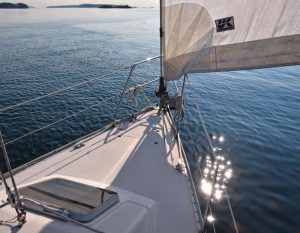
The bow is clean, with ground tackle stowed in a locker and cleats mounted quite far aft and near the rails.
The deck has a molded non-skid texture that has survived very well over the years. Contrary to the tradition of the day, the cabintop handrails are stainless steel, not high-maintenance teak. Musashi has four opening portlights on each side of the cabin trunk, a large deck hatch over the V-berth, another over the main cabin, and a smaller hatch over the head. For inclement weather, a single Dorade vent provides circulation in the main cabin. This is more than adequate ventilation for a boat sailed in Canada, where it’s more important to keep the rain out than let a tropical breeze in! That said, I am somewhat surprised that an opening port was not installed in the galley to help ventilate cooking moisture.
Sail tracks long enough for virtually any size headsail hug the cabin trunk, allowing for close sheeting angles. The mainsheet traveler is mounted on the cabintop over the companionway sea hood, keeping the traveler out of the cockpit. Although the cabintop would not be considered cluttered, the multiple hatches, sail control lines, and sea hood leave little room for feet.
Unlike more modern designs with shallow cockpits (allowing for tall, roomy aft cabins), the CS 30 has a wonderfully deep and secure cockpit. Seating is long and wide, with cutouts to accommodate the 36-inch wheel mounted on a guarded pedestal. Coamings are tall enough to provide excellent back support. Although the full height bridge deck ensures that any seas flooding into the cockpit won’t run into the cabin, it does make climbing into the cabin a bit more cumbersome.
For storage and access, there are three cockpit lockers, as well as a deep portside locker in the cockpit, that the average person can easily climb into for servicing the back end of the engine, transmission, hot water tank, and various electrical paraphernalia.
Accommodations
As I climbed over the bridge deck and into the companionway, my first impression was of bright, efficient use of space, with off-white interior panels that complement the teak trim.
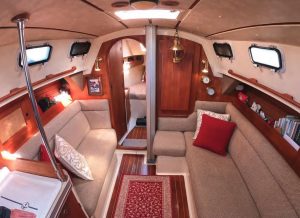
The use of numerous fiberglass moldings and composite panels is evident in this view of the saloon and forward cabin — most significantly, the pan that forms the sole and berth foundations. Note the molding that covers the bulkhead/deck join.
The U-shaped galley is immediately to port. A deep single sink with both pressure and hand-pumped water is near the centerline. A good-sized icebox is next to it against the hull. For longer sailing adventures, Jack has added a portable Dometic cooler/freezer. A gimbled two-burner propane range with oven is against the hull, with storage behind it. There is also excellent storage in a cabinet under the countertop.
To starboard is a small navigation station with a pull-out stool. There is limited room for navigational instruments, but the chart table will hold a typical-size chart book. Aft of the table is a double-wide, and very long, open quarter berth. Where many quarter berths are restricted in width by the engine compartment, on the CS 30 the engine is forward of this berth, and the mattress stretches all the way to the cockpit locker on the port side. There is certainly no sitting headroom under the cockpit sole, but lots of shoulder room.
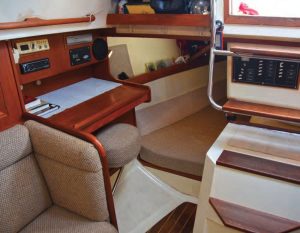
A dedicated nav station is unusual in a 30-foot boat; the swing-out stool permits easier access to the quarter berth.
The starboard settee can be pulled out into a double berth. The 30-gallon freshwater tank is located underneath. Additional storage is available behind the seatbacks. A fold-down table on the bulkhead easily seats four. Handholds include oiled teak rails that run the length of the cabin under the portlights, and a stainless steel post at the galley island.
Moving forward, the head is a separate compartment to starboard. Opposite it is a substantial hanging locker. The locker door performs double duty, also serving as a door for the V-berth, which is relatively small. Although there is a fill-in panel to create a wide mattress at the shoulders, the berth is relatively short for a 6-foot person.
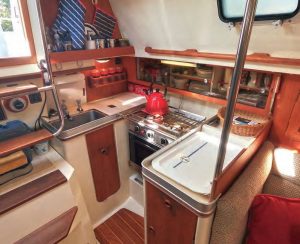
The compact galley has everything a cook needs to prepare tasty meals, and the U-shape provides security in a seaway.
Mechanical
Although the CS 30 was originally equipped with a two-cylinder Volvo Penta 2002 18-hp diesel engine, Musashi is now powered with a three-cylinder Beta 20 installed in 2020. Jack also replaced the 18-gallon aluminum fuel tank mounted behind the engine and the hot water tank in the cockpit locker.
Heating the interior to a comfortable level is critical in British Columbia, particularly in the shoulder seasons. An Espar diesel forced air furnace was added during a recent upgrade.
The electrical panel and battery switch are located behind the companionway, easily visible and accessible. Two 6-volt AGM house batteries are located under the portside settee, with two 12-volt starter batteries under the starboard settee. A solar panel atop the bimini frame over the aft end of the cockpit keeps the batteries topped up.

Plumbing for a shower is included in the head, which is simple to keep clean. With an opening port and deck hatch, ventilation is good.
Underway
Sailing conditions were challenging when I climbed aboard Musashi, with not a breath of wind on a calm fall day. Control under power was exactly as expected, the deep rudder in the prop wash providing precise directional control even at low speed. Backing down was dead straight. I was expecting prop walk in one direction or the other, but that was not evident. Jack cruises at about 2,500 rpm with 5.5 knots of boat speed. Engine noise in the cockpit was acceptable.
Motoring out over mirrored water, we found a patch of wind, then hoisted the main and pulled out the genoa. The Harken roller furling performed well. Both the full-batten main and 110% genoa were about 5 years old, with excellent shape. Musashi accelerated smoothly in the light 7 to 9 knots of breeze, heeling nicely and pointing well. The cockpit coaming on the leeward side was ideal for watching sail trim and reaching the genoa sheet winch. She tacked easily through 100 degrees and would likely do better with a bit more wind. The Whitlock geared steering was very sensitive to the touch, with excellent feedback and no noticeable slack — no cables to adjust or maintain. The wind was too light to cause any weather helm, but Jack reports that even in heavier air, with the sails trimmed properly, the CS 30 can go hands-off for long distances.
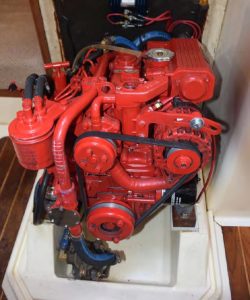
Access to the engine compartment is behind the bottom half of the companionway stairs, which are built into a large, removable fiberglass box. The Beta 20 has all major servicing points at the front of the engine, and access is excellent.
Although we didn’t have an opportunity to sail through any seas, Jack and Marilyn report that Musashi had no undesirable characteristics while sailing in ocean waves during their Vancouver Island circumnavigation. The boat was not squirrelly in heavy following seas, and they were quite confident in her capabilities.
The PHRF ratings for most fleets in the U.S. and Canada are 150 seconds per mile. A J/30’s numbers are very close at 144, while an O’Day 30’s are around 189.
Conclusion
I believe the CS 30 is exactly what Tony Castro intended all those years ago: a fast coastal cruiser designed without the constraints of racing rules. Fast under all points of sail, efficient under power, and nimble under both, the CS 30 exemplifies quality design and production. Fastidiously maintained, Musashi is a fine example of the heyday of volume production boats. I would have no hesitation taking this good old boat for extended coastal cruising, including open ocean sails off the West Coast of British Columbia.
A recent search for CS 30s for sale found only two, priced at $23,000 and $25,000.
Bert Vermeer and his wife, Carey, live in a sailor’s paradise. They have been sailing the coast of British Columbia for more than 30 years. Natasha, an Islander Bahama 30, is their fourth boat (following a Balboa 20, an O’Day 25, and another Islander Bahama 30). Bert tends to rebuild his boats from the keel up. Now, as a retired police officer, he also maintains and repairs boats for several non-resident owners.
Thank you to Sailrite Enterprises, Inc., for providing free access to back issues of Good Old Boat through intellectual property rights. Sailrite.com

